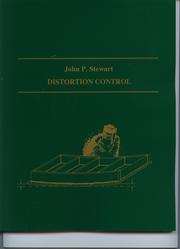Check nearby libraries
Buy this book

Identifies different types of distortion of welded materials and describes techniques to be used to control and eliminate the distortion.
This book of 15 chapters takes the mystery out of distortion control, and includes the following information:
• The different modes of distortion and how welded fabrications are affected
• Descriptions of various metal types and how the coefficient of expansion, thermal conductivity, yield strength, and modulus of elasticity affect distortion
• Design strategies and shop practices which should be learnt as the first basic step to controlling shrinkage
• Situations where appropriate restraining devices can make the difference between a quality product or a distorted weldment
• Various methods for correcting distortion, including flame shrinkage
• Procedure for bending and cambering beams using the power of weld shrinkage and flame straightening
• Applications of rapid cooling procedures and heat build up preventatives
• Tack welding skills combined with presetting techniques to overcome shrinkage problems when assembling weldments
• Tips on using mechanical aids and procedures for teaching simple weldment assembly
• Tools and devices, and how they are used to control distortion
• Measuring and monitoring methods using a variety of techniques and instruments
• Procedures for controlling distortion when welding and repairing light gauge sheet metal
• Description of jigs and fixtures and their uses when welding both mild steel and nickel alloy sheet
• Basic principles of pipe welding with practical examples of controlling distortion in problem areas
• Information on preheating and different forms of post heat treatments
• Techniques for preventing problems and controlling distortion during flame cutting
•http://johnstewartbooks.weebly.com/
Check nearby libraries
Buy this book

Subjects
Welded joints, Defects, Handbooks, manuals, WeldingShowing 1 featured edition. View all 1 editions?
| Edition | Availability |
|---|---|
|
1
Distortion control
1989, Fifth Printing 1994, John P. Stewart
Softcover
in English
0969284535 9780969284536
|
aaaa
Libraries near you:
WorldCat
|
Book Details
First Sentence
"Distortion Control is Everyone's Responsibility: every once in a while, though, something goes awry on the shop floor that results in twisted and warped work, and requires extra labor and unnecessary expenses to correct, if correction is at all possible. Quite often the job may have to be scrapped. Most of the time, no one really knows who is to blame, although the finger is easily, and sometimes unfairly, pointed at the welder or his boss."
Table of Contents
Edition Notes
Includes bibliographical references.
Classifications
The Physical Object
ID Numbers
Community Reviews (0)
Feedback?| March 30, 2011 | Edited by 74.56.100.28 | Url added for contacting the author |
| April 28, 2010 | Edited by Open Library Bot | Linked existing covers to the work. |
| March 17, 2010 | Edited by WorkBot | update details |
| December 10, 2009 | Created by WorkBot | add works page |










